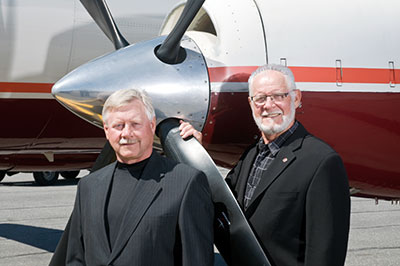
Features
Operations
Waypoint: The tenacity of a bear
The story of winning the North by air has been told over and over by many different voices.
November 14, 2013 By Rob Seaman
The story of winning the North by air has been told over and over by many different voices. Each one always finds a different and unique twist or aspect to share. And while we think we know the most common names and characters, the real story of flying the North is a never-ending one with new chapters being created all the time.
 |
|
| “I think it is safe to say we are both humbled and proud of what we have achieved.” PHOTO: Bearskin Airlines
|
Bearskin Airlines is one such example. As with many northern operations, the company began by serving communities that were otherwise hard to reach – except by air. This was back in July of 1963. Originally called Bearskin Lake Air Service, the company started from very humble beginnings with just two Cessna 180s – floats in the summer and skis in the winter. At that time, “the Bear” carried both passengers and cargo from a base at Big Trout Lake, which is 45 miles east of Bearskin Lake (270 miles northeast of Sioux Lookout and 400 miles northwest of Thunder Bay). Bush pilot Otto John Hegland started the operation. He did so primarily because he operated a general store on Bearskin Lake and needed to get groceries in for his customers. So began an airline that is now celebrating its 50th anniversary.
In 1970, a young and ambitious pilot named Harvey Friesen joined the company. Harvey obtained his private licence in 1967 while still in high school in Saskatchewan. He did his flight training at Ray’s Flying Service in Saskatoon and by 1969 had his commercial rating. Within a short period of time he was earning a living as a professional pilot, flying 180s on skies off the frozen lakes of northern Ontario.
Friesen loved the work and saw a great future for himself and Bearskin – so much so that in 1972 he bought a 50 per cent share of the company. Five years later, he became the majority owner and president. The following year, his brother Cliff (who was not a pilot) joined the company as executive vice-president.
Bearskin focused on providing charter service to the many remote First Nation communities in northern Ontario. Then in 1977, they launched their first scheduled service and began flying passengers between Big Trout Lake and Sioux Lookout. The following year, the “base of operation” was moved to Sioux Lookout where a new hangar, maintenance facilities and offices were built. By 1979, a scheduled route was launched between Sioux Lookout and Thunder Bay. A short year later, a new base was established in Thunder Bay following the purchase of On Air Ltd. Cliff Friesen then moved to Thunder Bay to oversee that base. In 1981, addition routes were added linking Sioux Lookout, Kenora and Winnipeg.
Right up until the late 1970s, most of Bearskin’s aircraft were bush planes – float-equipped in summer and ski-equipped in winter. By that time, the Ontario government was starting to pay attention to the challenges the smaller communities faced with seasonal freeze-up and thaw of the lakes – something that at times would totally halt air service. To overcome the problem of communities being cut off, the government undertook a program of airfield construction for many remote regions. Again showing its foresight, keen business acumen and adaptability to change, Bearskin began offering scheduled air service with wheeled aircraft to those communities. As Cliff Friesen says, “The northern airstrip development was just starting and the demand for wheel-equipped and larger aircraft was just beginning.”
In 1991, Bearskin bought the first two of what they are best known for today – Fairchild Metroliner aircraft. In the following year, they introduced non-stop service between Thunder Bay and Sudbury. This move heralded Bearskin Airlines’ growth eastward, making tracks throughout northeastern Ontario and eventually into Ottawa. Today, they are one of the largest fleet operators of the aircraft type. According to Cliff, “We chose the Metro because of its speed, comfort and fuel economy. It is one of the most economical pressurized 19-seat aircraft on the market. We moved to a single type in 2003/2004 related to reduced cost when using a single type and the fact it matched demand on most routes served.”
Harvey and Cliff are both amazed at how much things have changed. “No one could have predicted the growth that we have had,” says Cliff. “We started as a small two-plane operation and now fly turbine pressurized aircraft throughout North America. I think it is safe to say we are both humbled and proud of what we have achieved.”
In addition to their tremendous success, Harvey and Cliff Friesen have shown exemplary community involvement. The Air Transport Association of Canada will be recognizing this by honouring them with the first Jim Glass Humanitarian Award at ATAC’s annual general meeting in Montreal on Nov. 18.
Rob Seaman is a Wings writer and columnist.